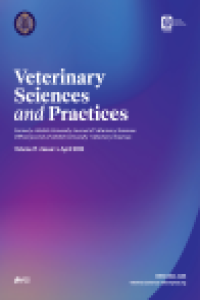Exposure to Terbinafine is Associated with Abnormal Skin Development in The Newborn Rats
Deri, Sıçan, Teratojenik, Terbinafin
The Relationship Between the Prenatal Exposure to Terbinafine and Abnormal Skin Development in the Newborn Rats
Rat, Skin, Teratogenicity, Terbinafine,
___
- Bahadir S., Inaloz HS., Alpay K., Agaoglu C., Cimsit G., Parlat P., Tak H., 2000. Continuous terbinafine or pulse itraconazole: A comparative study on onychomycosis. J. Eur. Acad. Dermatol. Venereol., 14, 422-423.
- Bar-Oz B., Moretti ME., Mareels G., VanTittelboom T., Koren G., 1999. Reporting bias in retrospective ascertainment of drug-induced embryopathy. Lancet, 13, 1700-1701.
- Bar-Oz B., Moretti ME., Bishais R., Mareels G., VanTittelboom T., Verspeelt J., Koren G., 2000. Pregnancy outcome after in utero exposure to itraconazole: a prospective cohort study. Am. J. Obstet. Gynecol., 183, 617-620.
- Begg EJ., 2008. Prescribing in pregnancy and lactation. Brit. J. Clin. Pharmaco., 65(5), 627-628.
- Contini C., Colombo D., Cultrera R., Prini E., Sechi T., Angelici E., Canipari R., 1996. Employment of terbinafine against pneumocystis carinii infection in rat models. Br. J. Dermatol., 46, 30-32.
- Czeizel AE., Metneki J., Kazy Z., Puho E., 2004. A population-based case-control study of oral griseofulvin treatment during pregnancy. Acta. Obstet. Gyn. Scan., 83(9), 827-831.
- De Santis M., Di Gianantonio E., Cesari E., Ambrosini G., Straface G., Clementi M., 2009. First-trimester itraconazole exposure and pregnancy outcome a prospective cohort study of women contacting teratology information services in Italy. Drug Saf., 32(3), 239-244.
- DeVane L., Goetzl LM., Ramamoorthy S., 2011. Exposing fetal drug exposure. Clin. Pharmacol. Ther., 89(6), 786-788.
- Deveci E., Inaloz SS., Inaloz HS., 1998. Teratogenic effects of cadmium on rat skin. Acta. Dermatologica-Kyoto., 93(2), 155-159.
- Fletcher H., Williams NP., Nicholson A., Rainford L., Phillip H., East-Innis A., 2000, Systemic phaeohyphomycosis in pregnancy and the puerperium. West. Indian. Med. J., 49, 79-82.
- Gupta AK., Shear NH., 1997. Terbinafine: an update. J. Am. Acad. Dermatol., 37(6), 979-988.
- Inaloz HS., Ketani MA., Inaloz SS., Yilmaz F., Ketani S., 2000a. The effects of sialoadenectomy and flutamide on skin development. Intl. J. Clin. Exp. Obst. Gynecol., 26, 231-234.
- Inaloz HS., Inaloz SS., Deveci E., Eralp A., 2000b. Teratogenic effects of nicotine on rat skin. Intl. J. Clin. Exp. Obst. Gynecol., 26, 241-243.
- Inaloz HS., Sari I., Inaloz SS., Bayhan G., Unal B., Yayla M., Eralp A., Yuncu M., 2000c. The effects of unilateral uterine artery ligation on skin development. Intl. J. Clin. Exp. Obst. Gynecol., 26, 218-220.
- Katic J., Fucic A., Gamulin M., 2010. Prenatal, early life, and childhood exposure to genotoxicants in the living environment. Arh. Hig. Rada. Toksikol., 61(4), 455-464.
- King CT., Rogers PD., Cleary JD., Chapman SW., 1998. Antifungal therapy during pregnancy. Clin. Infect. Dis., 27, 1151-1160.
- Leyden J., 1998. Pharmacokinetics and pharmacology of terbinafine and itraconazole. J. Am. Acad. Dermatol., 38, 42-47.
- Maldonado RA., Molina J., Payares G., Urbina JA., 1993. Experimental chemotherapy with combinations of ergosterol biosynthesis inhibitors in murine models of Chagas' disease. Antimicrob. Agents. Chemother., 37, 1353-1359.
- Mesaik MA., Khan KM., Rahat S., Choudhary MI., Murad S., Abdullah NR., Ahmad A., Siddiqui RA., 2005. Immunomodulatory properties of synthetic imidazolone derivatives. Lett. Drug. Des. Discov., 2(6), 490-496.
- Moore KL., Persaud TVN., Torchia MG., 2008. The developing human: clinically oriented embryology. 8th ed. 458-484, Saunders/Elsevier., Philadelphia.
- Moudgal W., Sobel JD., 2003. Antifungal drugs in pregnancy: a review. Expert. Opin. Drug. Saf., 2(5), 475-483.
- Rubin PC., 1986. Prescribing in pregnancy; General principles. Br. Med. J., 293, 1415–1417.
- Shehata HA., Nelson-Piercy C., 2000. Drugs to avoid in pregnancy. Cur. Obstet. Gynaecol., 10, 44-52.
- Suhonen R., Neuvonen PJ., 1997. The tolerability profile of terbinafine. Rev. Contemp. Pharmacother. 8, 373-386.
- van Gelder MM., van Rooij IA., Miller RK, Zielhuis GA, de Jong-van den Berg LT, Roeleveld N., 2010. Teratogenic mechanisms of medical drugs. Hum. Reprod. Update., 16(4), 378-394.
- Başlangıç: 2022
- Yayıncı: Atatürk Üniversitesi
Geriatrik Hasta Köpeklerde Fiziksel, Biyokimyasal ve Radyolojik Bulguların Değerlendirilmesi
Ali HAYDARDEDEOĞLU, Aslan KALINBACAK
Exposure to Terbinafine is Associated with Abnormal Skin Development in The Newborn Rats
İsmail CAN, Hüseyin Serhat İNALÖZ, Serap Sergül İNALÖZ, Necmetin KIRTAK, Ayhan ERALP, Gülname Fındık GÜVENDİ
